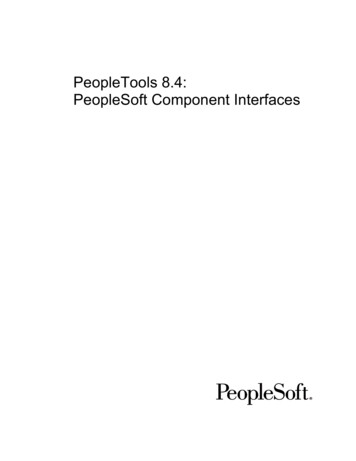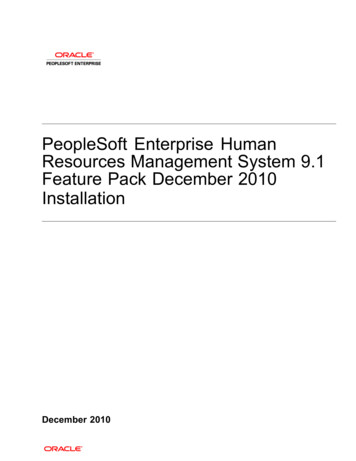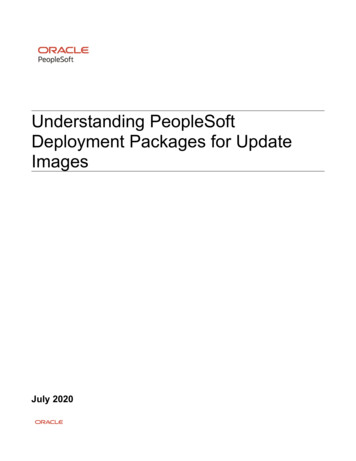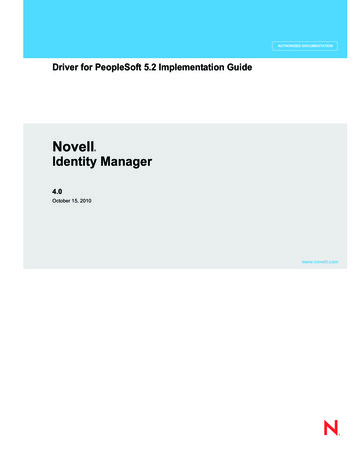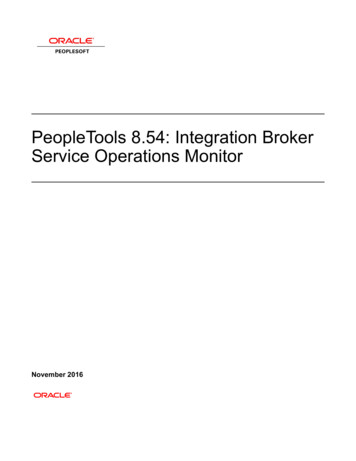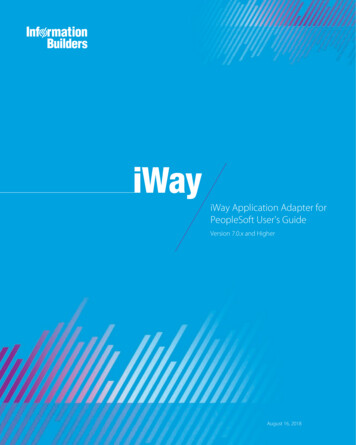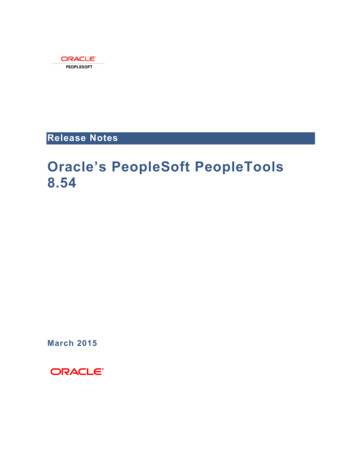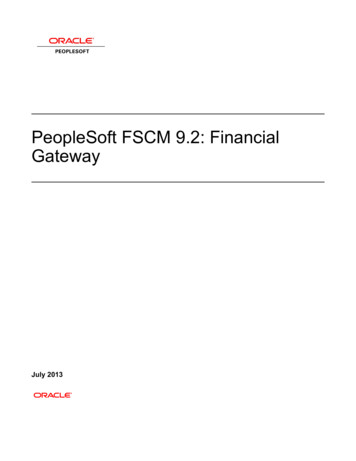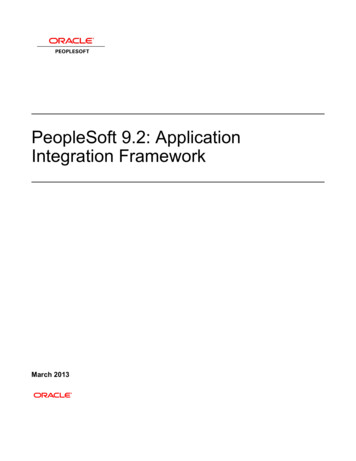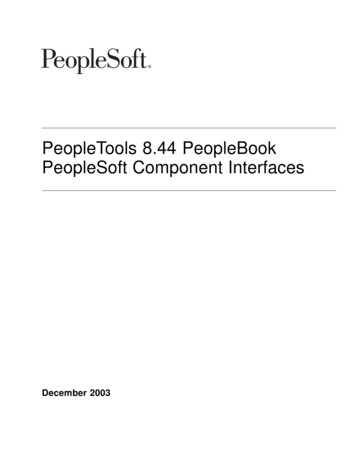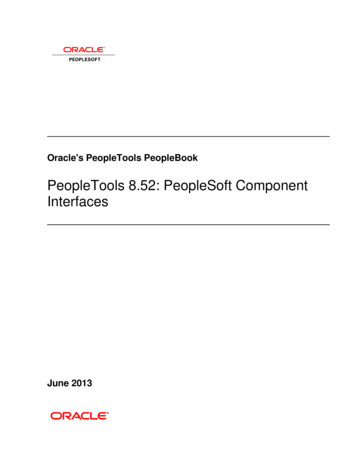
Transcription
Oracle's PeopleTools PeopleBookPeopleTools 8.52: PeopleSoft ComponentInterfacesJune 2013
PeopleTools 8.52: PeopleSoft Component InterfacesSKU pt8.52tcpi-b0613Copyright 1988, 2013, Oracle and/or its affiliates. All rights reserved.Trademark NoticeOracle is a registered trademark of Oracle Corporation and/or its affiliates. Other names may be trademarks of theirrespective owners.License Restrictions Warranty/Consequential Damages DisclaimerThis software and related documentation are provided under a license agreement containing restrictions on use anddisclosure and are protected by intellectual property laws. Except as expressly permitted in your license agreement orallowed by law, you may not use, copy, reproduce, translate, broadcast, modify, license, transmit, distribute, exhibit,perform, publish or display any part, in any form, or by any means. Reverse engineering, disassembly, or decompilationof this software, unless required by law for interoperability, is prohibited.Warranty DisclaimerThe information contained herein is subject to change without notice and is not warranted to be error-free. If you findany errors, please report them to us in writing.Restricted Rights NoticeIf this software or related documentation is delivered to the U.S. Government or anyone licensing it on behalf of the U.S.Government, the following notice is applicable:U.S. GOVERNMENT RIGHTSPrograms, software, databases, and related documentation and technical data delivered to U.S. Governmentcustomers are "commercial computer software" or "commercial technical data" pursuant to the applicableFederal Acquisition Regulation and agency-specific supplemental regulations. As such, the use, duplication,disclosure, modification, and adaptation shall be subject to the restrictions and license terms set forth in theapplicable Government contract, and, to the extent applicable by the terms of the Government contract, theadditional rights set forth in FAR 52.227-19, Commercial Computer Software License (December 2007).Oracle USA, Inc., 500 Oracle Parkway, Redwood City, CA 94065.Hazardous Applications NoticeThis software is developed for general use in a variety of information management applications. It is not developed orintended for use in any inherently dangerous applications, including applications which may create a risk of personalinjury. If you use this software in dangerous applications, then you shall be responsible to take all appropriate fail-safe,backup, redundancy and other measures to ensure the safe use of this software. Oracle Corporation and its affiliatesdisclaim any liability for any damages caused by use of this software in dangerous applications.Third Party Content, Products, and Services DisclaimerThis software and documentation may provide access to or information on content, products and services from thirdparties. Oracle Corporation and its affiliates are not responsible for and expressly disclaim all warranties of any kindwith respect to third party content, products and services. Oracle Corporation and its affiliates will not be responsible forany loss, costs, or damages incurred due to your access to or use of third party content, products or services.
ContentsPrefacePeopleSoft Component Interfaces Preface . ixPeopleSoft Component Interfaces . ixPeopleBooks and the PeopleSoft Online Library . ixChapter 1Getting Started with PeopleSoft Component Interfaces . 1Overview . 1Implementing PeopleSoft Component Interfaces . 1Implementing the Excel to Component Interfaces Utility . 2Chapter 2Understanding Component Interfaces . 3Understanding Component Interfaces .Component Interface Architecture .Component Interface Attributes .Name .Keys .Properties .Collections .Methods .Component Interface Definitions and Views .334444555Chapter 3Developing Component Interfaces . 9Creating Component Interface Definitions . 9Understanding Creating Component Interface Definitions . 9Creating New Component Interfaces . 10Naming Component Interface Definitions . 12Associating Component Interfaces with Menus . 12Copyright 1988, 2013, Oracle and/or its affiliates. All Rights Reserved.iii
ContentsDetermining the Fields to Expose in Component Interfaces .Using Keys .Understanding Keys .Adding and Deleting Keys .Setting Properties .Understanding Standard Properties .Creating User-Defined Properties .Deleting User-Defined Properties .Renaming User-Defined Properties .Creating Reference Properties .Making Properties Read-Only .Working with Collections .Working with Methods .Understanding Session Functions and Methods .Understanding Standard Methods .Understanding Collection Methods .Enabling and Disabling Standard Methods .Creating User-Defined Methods .Exporting User-Defined Methods .Validating Component Interfaces .Setting Security Options .Testing Component Interfaces .Searching Component Interfaces to Test .Testing Component Interfaces .Determining ItemByKeys Parameters .Understanding Synchronization .Writing Component Interface Programs .Understanding Runtime Considerations .General Considerations .Scope Conflicts .Interactive Mode 2535455555556Chapter 4Programming Component Interfaces Using PeopleCode . 57Understanding PeopleCode Behavior and Limitations .PeopleCode Event and Function Behavior .CopyRowset Language Considerations .Limitations of Client-Only PeopleCode .Generating PeopleCode Templates to Access Component Interfaces .Understanding PeopleCode Templates .iv575759595961Copyright 1988, 2013, Oracle and/or its affiliates. All Rights Reserved.
ContentsChapter 5Programming Component Interfaces in Java . 63Building APIs in Java .Setting Up the Java Environment .Generating Java Runtime Code Templates .Understanding the Java Template .63646566Chapter 6Programming Component Interfaces in C . 71Building APIs for C .Setting Up the C Environment .Setting Up Client Machines to Access C APIs .Configuring Compilers for C Projects .Generating C Runtime Code Templates .Understanding the C Template .717272727375Chapter 7Programming Component Interfaces in COM . 79Understanding Programming Interfaces in COM .Building APIs for COM .Setting Up the COM Environment .Generating Visual Basic Runtime Code Templates .Understanding Visual Basic Templates .Exposing and Deploying External COM APIs in Visual Basic .NET Environments .Exposing PeopleSoft COM APIs in Visual Basic .NET Environments .Deploying PeopleSoft COM APIs in Visual Basic .NET Environments .7979808283858587Chapter 8Using the Component Interface Software Development Kit . 89Understanding the Component Interface SDK .Component Interface SDK Samples .Prerequisites for Using the Component Interface SDK .Using the SDK BUS EXPENSES Test Page .Testing the SDK BUS EXP Component Interface .Copyright 1988, 2013, Oracle and/or its affiliates. All Rights Reserved.8989909091v
ContentsUsing the Component Interface SDK Sample in Java and C . 91Understanding using the Component Interface SDK Samples in Java and C . 91Building the Component Interface SDK Sample (Java) . 91Building the Component Interface Sample (C ) . 91Running the Component Interface SDK Sample in Java and C . 92Interpreting the Code for the Component Interface SDK Sample (Java) . 92Interpreting the Code for the Component Interface SDK Sample (C ) . 94Using the Component Interface SDK COM Excel Sample . 95Running the Component Interface SDK COM Excel Sample . 96Understanding the Component Interface SDK COM Excel Sample Code . 97Using the Component Interface SDK COM ASP Sample . 98Running the Component Interface SDK COM ASP Sample . 98Understanding the Component Interface SDK COM ASP Sample Code . 100Chapter 9Using the Excel-to-Component Interface Utility . 107Understanding the Excel-to-Component Interface Utility .Prerequisites for Using the Excel to CI Utility .Understanding Building Component Interfaces for the Excel to Component Interface Utility .Testing Component Interfaces .Performance Expectations .PeopleCode Behavior and Limitations .Default Properties .Running the Excel to Component Interface Utility .Granting Access to the WEBLIB SOAPTOCI iScript .Enabling the Developer Menu in Microsoft Excel 2007 and Later Versions .Enabling Macros in Microsoft Excel .Starting the Excel to Component Interface Utility .Converting Excel to Component Interface Utility Templates to the Current Excel Version .Viewing the Excel to Component Interface Coversheet .Setting Up Connection Information .Entering Connection Information .Translations and Multilingual Support .Connecting to the Database to Create a Template and Submit Data .Creating Templates .Understanding the Template Actions Toolbar .Entering Data into the Template .Entering Data on the Data Input Sheet .Using the Data Input Sheet .Viewing the Staged Data .Correcting and Resubmitting Data .Creating SOAP/XML Requests 4117117118120122123123125126127Copyright 1988, 2013, Oracle and/or its affiliates. All Rights Reserved.
ContentsRequest Format .Sample Create Request .Sample Get Request .Sample Update Request .Sample Updatedata Request .Sending Requests .Receiving Responses .Viewing a Response if a Row Already Exists .Viewing a Sample Get Request and Response .Diagnosing and Resolving Errors .Viewing Log Files .Resolving Error Messages for Client Environments .127127128128128129129129130131131131Appendix ACreating Component Interface-Based Services . 133Understanding Generating Component Interfaced-Based Services . 133Appendix BUsing Services to Validate Prompt Table and Translate Field Values . 135Understanding Validating Prompt Table and Translate Field Values . 135Prerequisites for Validating Prompt Table and Translate Field Values . 136Validating Prompt Table Field Values . 136Understanding Validating Set Control Fields . 136Using the PTLOOKUPPROMPT Service Operation . 136Validating Translate (XLAT) Field Values . 137Understanding Translate (XLAT) Table Entries . 137Understanding Security When Validating Translate (XLAT) Field Values . 138Using the PTLOOKUPXLAT Service Operation . 138Using Messages to Request Valid Prompt Field and Translate (XLAT) Field Values . 138Using Response Messages to Retrieve Valid Prompt Field and Translate (XLAT) Field Values . 140Examples: Validating Prompt Field and Translate (XLAT) Field Values . 141Example 1: Validating a Translate (XLAT) Field . 141Example 2: Performing a Prompt Table Lookup with a Field Value Wildcard . 142Example 3: Filtering Field Values by Name/Value Pairs . 144Example 4: Specifying Set Control Field Values to Validate Field Values Controlled by Set ControlFields . 146Example 5: Specifying Set Control ID Values to Validate Field Values Controlled by Set ID Values .147Copyright 1988, 2013, Oracle and/or its affiliates. All Rights Reserved.vii
ContentsIndex . 149viiiCopyright 1988, 2013, Oracle and/or its affiliates. All Rights Reserved.
PeopleSoft Component Interfaces PrefaceThis book describes PeopleSoft component interfaces. It is written for programmers who will be accessingPeopleSoft components, usually using external systems.PeopleSoft Component InterfacesA PeopleSoft component interface is a PeopleTools definition that you create in PeopleSoft ApplicationDesigner. It enables synchronous access to a PeopleSoft component from another application.PeopleBooks and the PeopleSoft Online LibraryA companion PeopleBook called PeopleBooks and the PeopleSoft Online Library contains generalinformation, including: Understanding the PeopleSoft online library and related documentation. How to send PeopleSoft documentation comments and suggestions to Oracle. How to access hosted PeopleBooks, downloadable HTML PeopleBooks, and downloadable PDFPeopleBooks as well as documentation updates. Understanding PeopleBook structure. Typographical conventions and visual cues used in PeopleBooks. ISO country codes and currency codes. PeopleBooks that are common across multiple applications. Common elements used in PeopleBooks. Navigating the PeopleBooks interface and searching the PeopleSoft online library. Displaying and printing screen shots and graphics in PeopleBooks. How to manage the locally installed PeopleSoft online library, including web site folders. Understanding documentation integration and how to integrate customized documentation into the library. Application abbreviations found in application fields.You can find PeopleBooks and the PeopleSoft Online Library in the online PeopleBooks Library for yourPeopleTools release.Copyright 1988, 2013, Oracle and/or its affiliates. All Rights Reserved.ix
Chapter 1Getting Started with PeopleSoftComponent InterfacesThis chapter provides an overview of PeopleSoft component interfaces and discusses how to implement them.OverviewA component interface is a set of application programming interfaces (APIs) that you can use to access andmodify PeopleSoft database information programmatically. PeopleSoft component interfaces expose aPeopleSoft component (a set of pages grouped for a business purpose) for synchronous access from anotherapplication (PeopleCode, Java, C/C , or Component Object Model [COM]). A PeopleCode program or anexternal program (Java, C/C , or COM) can view, enter, manipulate, and access PeopleSoft componentdata, business logic, and functionality. Additionally, you can use the Component Interface Tester to check thevalidity of your component interface and the Excel to Component Interface Utility to manage your data.Component interfaces are created in PeopleSoft Application Designer, so you should ensure that you arefamiliar with PeopleTools and Application Designer.See PeopleTools 8.52: PeopleSoft Application Designer Developer's Guide.This section provides information to consider before you begin to use PeopleSoft component interfaces. Inaddition to implementation considerations presented in this section, take advantage of all PeopleSoft sourcesof information, including the installation guides, release notes, and PeopleBooks.Implementing PeopleSoft Component InterfacesPeopleSoft PeopleTools include the functionality to create component interfaces for your applications.Complete the following tasks before you begin creating component interfaces for your implementation: Install your Application according to the installation guide for your database type.See the PeopleSoft installation guide for your platform and product line. Establish a user profile that gives you access to PeopleSoft Application Designer and any other processesthat you will use.See PeopleTools 8.52: Security Administration, "Understanding PeopleSoft Security."Copyright 1988, 2013, Oracle and/or its affiliates. All Rights Reserved.1
Getting Started with PeopleSoft Component InterfacesChapter 1Implementing the Excel to Component Interfaces UtilityPeopleSoft provides the Excel to Component Int
A component interface is a set of application programming interfaces (APIs) that you can use to access and modify PeopleSoft database information programmatically. PeopleSoft component interfaces expose a PeopleSoft component (a set of pages grouped for a business purpose) for synchronous access from another
